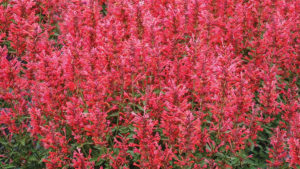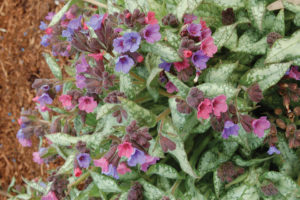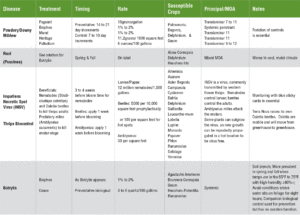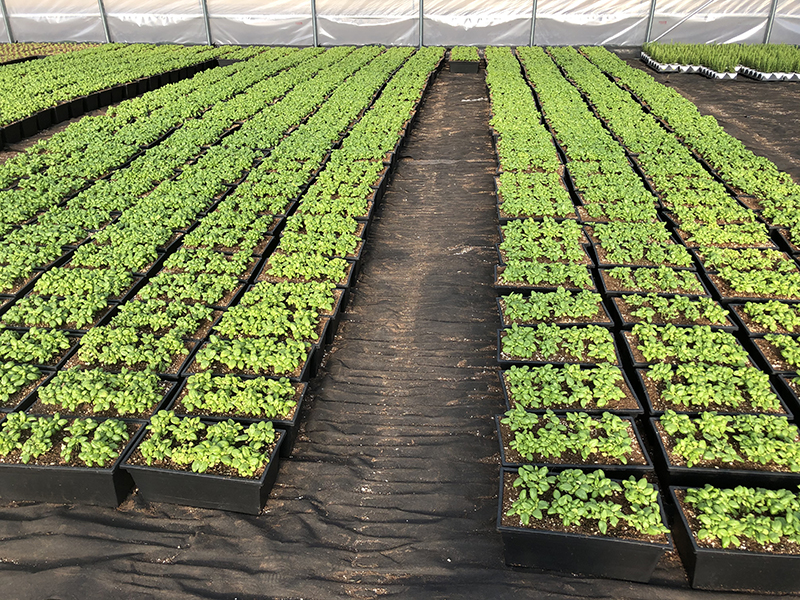How to Keep Your Perennials Healthy and Disease-Free

Starting with disease-resistant varieties saves you time, money, and labor. The Agastache Kudos Series is bred to be resistant to downy mildew.
Nobody likes diseased plants. When opening cases of plugs or cuttings from producers around the world, it’s reasonable to expect healthy plants. Disease takes its toll on a plant, delaying the ready time, stunting or disfiguring it, or at the worst, killing it.
Terra Nova Nurseries has to approach disease with the utmost of seriousness. Most of its plants are from tissue culture. As one spore or one bacterium can destroy a culture of plants, it starts with the cleanest of stock, already tested for viruses before initiation. Once a plant hits the greenhouse for weaning, growers do a two-fold approach to prevent disease: culture and sprays.
Culture
One must monitor a raft of conditions to prevent disease. Horizontal ventilation, humidity and temperature control, no overhead irrigation, and morning and daytime watering are all areas where one element out of control can devastate a crop. Handling a diseased plant without sanitation of hands and tools afterward is a great way to inoculate a crop. Be aware!
Scouting
Scouting for problems is the responsibility of all. No grower can be everywhere at every time, so it is beneficial to train all who pass through the threshold of the greenhouse to be aware of disease (and insect) damage. A poster of disease pictures in the breakroom can be a constant reminder along with training. Viruses are more difficult to pinpoint but can be verified by using Agdia Immunostrip test kits for on-site plant viral analysis. These can determine the presence of tospoviruses like impatiens necrotic spot virus (INSV). Check out Agdia.com for more information.

Some genera like Pulmonaria used to show an 85% infection rate amongst the hybrid seedlings, after five years of breeding, this is down to 5%. Pictured is Pulmonaria ‘High Contrast,’ a Terra Nova variety bred to be resistant to powdery mildew.
Monitoring
Blue sticky cards can help determine the presence of thrips — the principal vector of INSV, a hugely non-discriminate virus.
Treatment
Once a disease is confirmed, it’s time to find the best preventative — timing, rate, and time of application and reentry are important. Always use a cycle of two to three active chemicals to prevent resistance. Here are some examples of how Terra Nova Nurseries treats its top two.
Botrytis and Rust (Puccinea) Control:
1. Pageant: Mode of Action (MOA) group 7 to 11, preventive spray application at time of sticking cuttings, rate 15 grams/3 gallons
2. Palladium: MOA group 9 to 12, spray application at first sign of botrytis sporulation, rate 6 ounces/100 gallons
3. Orkestra: MOA group 7 to 11, spray application, botrytis rotation, rust preventative, 8 ounces/100 gallons
Spring and fall application is most effective for Rust control. This rotation has proved to be effective for both Botrytis and Rust control. The fungicides are applied by spray and work by tissue contact.
Powdery Mildew Spray Rotation:
1. MOA 7 to 11 (Pageant, Orkestra, Mural,) Heritage (MOA 11)
2. Rotate MOA 7 to 11 with MOA 9 to 12 (Palladium)
For more detailed information on prevention/control of disease, as well as how INSV can be prevented through thrips control, refer to the chart below.

Save Yourself the Hassle, Start With Disease-Resistant Genera
It’s better to start with a plant that has been bred to be disease resistant, which results in plants that are successful for the grower and ultimately, the consumer. In our trials, thousands of hybrids are observed. Many times plants are inoculated by spraying them with a water spray deflected off a mildewed specimen. If disease pops up, our ruthless breeders yell, “Off with its head!” and the plant is removed. Some genera like Pulmonaria used to show an 85% infection rate amongst the hybrid seedlings. In five years of breeding, this was down to 5%. Remember: Disease-resistant plants save time, money, and labor.
Disclaimer: It is always the pesticide applicator’s responsibility, by law, to read and follow current label directions for the specific pesticide being used. The authors, Terra Nova Nurseries, assume no liability resulting from the use of any listed information for educational, governmental, or commercial use of pesticides mentioned. Please rely on pest control suggestions from your local county Extension office, Department of Agriculture, or land-grant university, as pesticide uses vary between states, municipalities, and countries.










